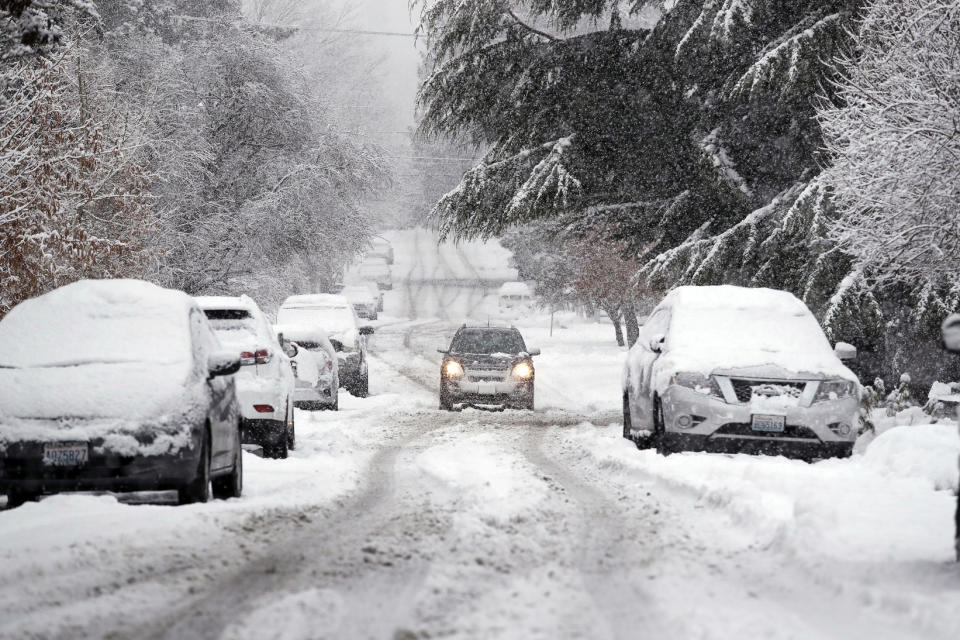Cold snap may be your signal to get new tires for winter
DETROIT (AP) — With the eastern two-thirds of the U.S. shivering through an early blast of arctic air, it’s time to start thinking about whether your car’s tires will get you safely through the winter.
Italian tiremaker Pirelli last week started a campaign telling people that winter tires aren’t just for climates with frequent ice and snow. The company says that’s because winter tires work far better than all-season tires in areas where temperatures regularly drop below 44 degrees Fahrenheit (6.7 degrees Celsius), whether the pavement is wet or dry.
The reason, according to Pirelli, is that the rubber compound of winter tires is designed to stay soft below 44 degrees, improving the ability to grip the road, shortening stopping distances and handling better.
Experts say it is generally true that cars with winter tires stop and steer better in the cold. But many all-season tires now can stay pliable in freezing temperatures and will work well for drivers even in cold climates. Plus, when the mercury fluctuates back to warmer temperatures, all-season tires likely will perform better than winter tires.
Ian Coke, chief technical officer for Pirelli North America, said the need for winter tires depends on how long it stays below 44 and whether it’s that cold when you’re driving. As temperatures drop to 44 or lower, non-winter tires will get stiffer, cutting tread traction and increasing stopping distance, Coke said.
“The tires are the only four points of the car that touch the road,” he said. “It’s a safety critical item. We want to make people aware of how to get the best out of their tires.”
Winter tires, he said, make your car safer not just for you, but for other drivers and pedestrians who may be along the road.
In about two-thirds of the U.S., the temperature drops to 44 degrees or below at least 130 days per year, according to data from Brian Brettschneider, a research associate at the University of Alaska Fairbanks. States normally known for moderate climates including northern sections of Georgia, South Carolina and Alabama, much of California, and parts of southern Arizona see 44 degree lows from 130 to 170 days annually. Parts of the Florida panhandle get at least 90 days per year with 44 degree or lower temperatures, according to a map that Brettschneider created based on the data.
Coke said winter tires aren’t needed in areas where the temperature dips below 44 for a short time but warms up rapidly. Yet he says they are critical when the temperature is below 44 for longer periods, like during an entire commute.
European tiremakers have portrayed temperatures in the low 40s Fahrenheit (4 to 7 degrees Celsius) as a “hard line” where winter tires are a must, but with some all-season tires, that’s not necessarily correct, said Woody Rogers, director of tire product information for Tire Rack, an online tire store in South Bend, Indiana, that does tire testing. “I think in reality, in practicality, it’s more a gray area transition than a hard line,” Rogers said.
Some all-season tires can get stiff when it gets cold, but many can grab the road well into the 30s (4 above to 1 below zero Celsius), he said. “All all-season tires are not created equal,” said Rogers.
Some tiremakers have created another category of tire called all-weather, and they’ve been able to stamp on the sidewalls a symbol with a snowflake and three mountain peaks indicating the tires work well in winter. To use that symbol, tiremakers have to meet an industry standard of performing at least 10% better than a reference tire, Rogers said. But he said many winter tires outperform the reference tire by 25% to 30%.
“For sure, winter tires do provide a commanding advantage on snow and ice,” said Gene Petersen, tire program manager for Consumer Reports.
On its test track in Connecticut, Consumer Reports compared about a half-dozen all-season tires to winter tires from the same brand. In cold, dry conditions, all-season tires had a shorter stopping distance than winter tires, Petersen said. But Petersen said the surface on Consumer Reports’ track is easier for tires to grip than normal pavement.
The decision on winter tires comes down to how often you have to drive in snow and ice, Petersen says. “It’s not necessarily a clear decision, but it’s a decision you have to make on how you might drive, how often you drive in snow, whether you have the type of job that you can stay home in bad weather,” he said.
Winter tires for a Toyota RAV4, a top-selling small SUV, run from about $125 to $162 each at Tire Rack. All-season tires are cheaper, starting as low as $96.
Experts say to determine if your tires have enough tread depth for winter, stick a quarter into the grooves at several spots with George Washington’s head upside down. If you can see the top of Washington’s hair, you have 4/32 of an inch (3.2 millimeters) of tread, or less. That means it’s about time to replace your tires.



